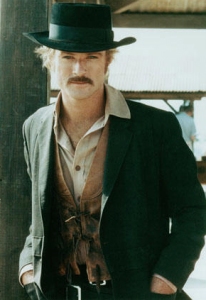 BUTCH CASSIDY AND THE SUNDANCE KID
BUTCH CASSIDY AND THE SUNDANCE KID
Outlaws as western heroes
Butch Cassidy and the Sundance Kid (1969) is a pivotal film in Robert Redford’s career because it made him a star and gave him the clout in the industry that he longed for, to gain more control over future projects, after working for years in movies that he didn’t particularly like and getting in trouble with studios for refusing to do films when he was under contract. This film also established his persona as a western outlaw, an image that Redford has consistently been identified with and that he himself embraces, having often expressed his sympathy for Indians and outlaws.
The script by William Goldman was originally called The Sundance Kid and Butch Cassidy, but when Paul Newman was picked for the role of Cassidy, the names were reversed. Newman was a star at the height of his popularity who had already played memorable western heroes in Hombre (1966), Hud (1963) and The Left-Handed Gun (1962). One of the problems the filmmakers were facing was that Robert Redford was not a well-known actor at the time; in fact producer Richard Zanuck wanted to cast Steve McQueen (Jack Lemmon, Warren Beatty and Marlon Brando were also considered). But George Roy Hill and Paul Newman (upon a recommendation from Joanne Woodward) insisted on the more youthful actor, who fit the part because similarly not much is known about Harry Alonzo Longabaugh, the dangerous outlaw nicknamed the Sundance Kid from a place in Wyoming. Robert Leroy Parker, who was known as Butch Cassidy, the leader of the “Hole in the Wall” gang, had picked Longabaugh as his partner, after his longtime associate William Ellsworth “Elzy” Lay ended up in jail in 1899; in fact, Butch’s sister, Lula Betenson, who visited the set and met the actors playing the real-life outlaws, claims in her book that “most of the episodes in the movie involved Elzy Lay instead of the Sundance Kid.”
(To read more) Buy the book, Robert Redford and the American West.